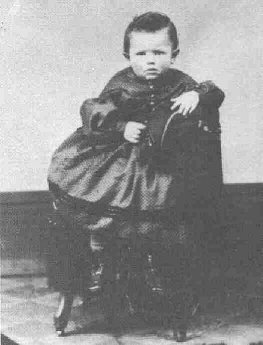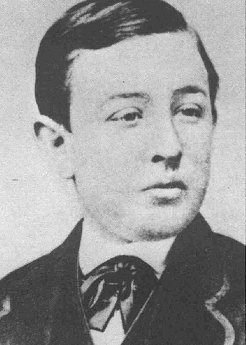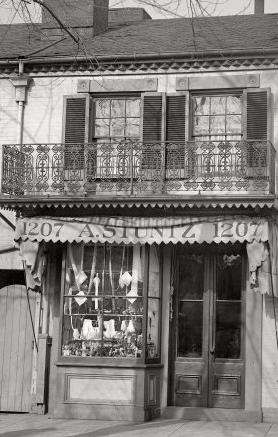Tad Lincoln |
|
|
Tad as a very young child and as a teenager
|
|
Thomas Lincoln ("Tad") was the fourth and last child of Abraham and Mary Todd Lincoln. He was born on April 4, 1853. Tad was named after Thomas Lincoln, Abraham's father who had died in 1851. Tad's head was unusually large at birth. Abraham, viewing the contrast between the large head and tiny baby figure, thought he resembled a tadpole which was the origin of a nickname that stuck for the rest of Tad's life.
As a young lad growing up, Tad had an appealing boyish face with dark hair like his dad's. His eyes were dark. Tad was quick in his movements, talked rapidly, and had a marked speech impediment. It is probable that Tad had at least a partial cleft palate, and he spoke with a lisp. He was imaginative, sensitive, exasperating, loving, and highly emotional. Tad's behavior and manners were often unpredictable and sometimes difficult to deal with.
Tad was eight when the Lincoln family moved into the White House in 1861. (The photo to the right is Stuntz's Fancy Store, 1207 New York Avenue, Northwest, in Washington. This is where the president took Tad to buy toys. The photo is from the Columbia Historical Society.) Although Tad was more rambunctious than his brother, Willie, both boys enjoyed playing pranks around the Executive Mansion. In the White House Tad sprayed dignitaries with the fire hose, broke mirrors, locked doors, interrupted Cabinet meetings, constructed wagons and sleds out of chairs, set up a food shop in the lobby, rang the call bells, and drilled the servants, as if they were soldiers. Abraham generally laughed at his sons' tricks, and any kind of discipline was generally lacking.
|
|
|
|
Tad seemed to enjoy the idea of throwing the White House and its staff into a dither. Because of the times, some of Tad's games were war-related. He received a pretend military commission from Secretary of War Edwin Stanton. (The National Archives photo to the left shows Tad in the Union uniform that Stanton allowed him to wear.) Mrs. Lincoln hired tutors for the boys, but only Willie took education seriously. Regarding Tad the president's secretary, John Hay, wrote, "He had a very bad opinion of books and no opinion of discipline." The attitude of the parents was basically "let the children have a good time."
Like Abraham and Mary, young Tad loved the theater. At Grover's Theatre Tad often went to rehearsals and became a familiar figure backstage. He became quite a hit with the stage workmen. He personally appeared in at least two plays when his dad was in the audience.
When John Wilkes Booth shot his father at Ford's Theatre, Tad was at Grover's Theatre watching "Aladdin or The Wonderful Lamp." He was accompanied by Alphonso Donn, one of the group of Metropolitan Washington police officers assigned to the White House. During the play information about the president's shooting was whispered in Donn's ear.
|
|
After Tad had departed, an actor or theater manager stepped onto the stage and announced the tragedy to the audience. Tad was taken back to the White House and comforted by a member of the White House staff, Tom Pendel. Pendel put Tad to bed around midnight. The next morning when Mary returned from the Petersen House and news of Abraham's death spread, Tad put his arms around his mother's neck and said, "Don't cry so, Mamma! Don't cry, or you will make me cry, too! You will break my heart!" |
One morning several days after the assassination, Tad faced up to his new situation in life. He said to a White House servant, "Pa is dead. I can hardly believe that I shall never see him again. I must learn to take care of myself now. Yes, Pa is dead, and I am only Tad Lincoln now, little Tad, like other little boys. I am not a president's son now. I won't have many presents anymore. Well, I will try and be a good boy, and will hope to go someday to Pa and brother Willie, in heaven." |
|
Author Ruth Painter Randall writes that Tad made the news on May 18, 1865. A newspaper reported, "Master Tad Lincoln was among the spectators at the conspiracy trial this afternoon." Tad had probably grown restless in the White House prior to departure and was looking to do something with his time. On May 22 the Lincolns left the White House.
The Lincoln family moved to Chicago, and Mary became increasingly concerned about Tad's lack of schooling. In 1865 at age 12 he could not write and was almost completely illiterate despite having been tutored in the White House. Tad began to attend school in Chicago in January of 1866. When the family moved to a new location in Chicago, Tad began attending the Brown School on Warren Avenue. There Tad was editor of the school newspaper. In 1867 Tad and his brother traveled to Washington to testify in the trial of John Surratt who was accused of conspiring with John Wilkes Booth.
In 1868 Mary decided to travel to Europe. On October 1, 1868, Mary and Tad sailed out of New York. It would be 2 1/2 years before Tad would set foot on American soil again. The two Lincolns settled in Frankfurt, Germany, and Tad was enrolled in a boarding school operated by Dr. Hohagen. The school had an excellent reputation. Tad and his mother were very close. In December 1869 Mary wrote to her friend, Sally B. Orne, "Taddie is like some old woman with regard to his care of me. His dark, loving eyes watching over me remind me so much of his dearly beloved father's." In 1870, because of the Franco-Prussian War, the Lincolns moved to England. There Tad had a private tutor.
In 1871 Mary decided to return to the United States. On May 11 Mary and Tad arrived in port, and on May 15 they left for Chicago. It seems Tad had caught a cold during the ocean voyage and was not well when he arrived in Chicago.
By late May Tad developed difficulty in breathing when lying down and had to sleep sitting up in a chair. By early June he was dangerously ill. He then rallied for a short time. As July approached he weakened again. Tad's pain and agony worsened as his face grew thinner. On Saturday morning, July 15, 1871, Tad passed away at the age of 18. The cause of death was most likely tuberculosis. Tad's death occurred in the Clifton House in Chicago.
Simple funeral services were held for Tad the next day in Robert Lincoln's Chicago home. Tad was to be buried in the Lincoln Tomb in Springfield, and Robert accompanied the casket on the train. Mary was too overcome to make the trip. In Springfield more formal funeral services were held at the First Presbyterian Church. Then Tad's remains were transported to Oak Ridge Cemetery to be placed with the remains of his father, Abraham, and two brothers, Eddie and Willie.
Sources include Lincoln: An Illustrated Biography by Philip B. Kunhardt, Jr., Philip B. Kunhardt III, and Peter W. Kunhardt, Lincoln's Sons by Ruth Painter Randall, and Mary, Wife of Lincoln by Katherine Helm. Also, many details of Tad's life are included in John D. Weaver's Tad Lincoln: Mischief Maker in the White House.
The photo at the top (left) is from the Lloyd Ostendorf Collection. The photo at the top (right) is from the Chicago History Museum.
Dr. John M. Hutchinson, president of Beacon College, has published extensive research on Tad's speech and language disorder. To read Dr. Hutchinson's research please CLICK HERE.
|
|
This is not a commercial website. None of the photographs and artwork exhibited herein are being sold by the webmaster. Some photographs and artwork are believed to be in the public domain. Any copyrighted photographs and artwork are used in the context of this website strictly for educational, research and historical purposes only, under the "Fair Use" provisions of the Copyright Act, (US CODE: Title 17,107. Limitations on exclusive rights: Fair Use Section 107). Anyone claiming copyright to any of the posted photographs or artwork please inform the webmaster of such and it will be duly noted or removed.
This page is part of the Abraham Lincoln Research Site. Questions, comments, corrections or suggestions can be sent to R. J. Norton, the creator and maintainer of this site. All text except reprinted articles was written by the webmaster, ©1996-2021. All rights reserved. It is unlawful to copy, reproduce or transmit in any form or by any means, electronic or hard copy, including reproducing on another web page, or in any information or retrieval system without the express written permission of the author. The website was born on December 29, 1996.
Web design by Andrew Patel.
|




